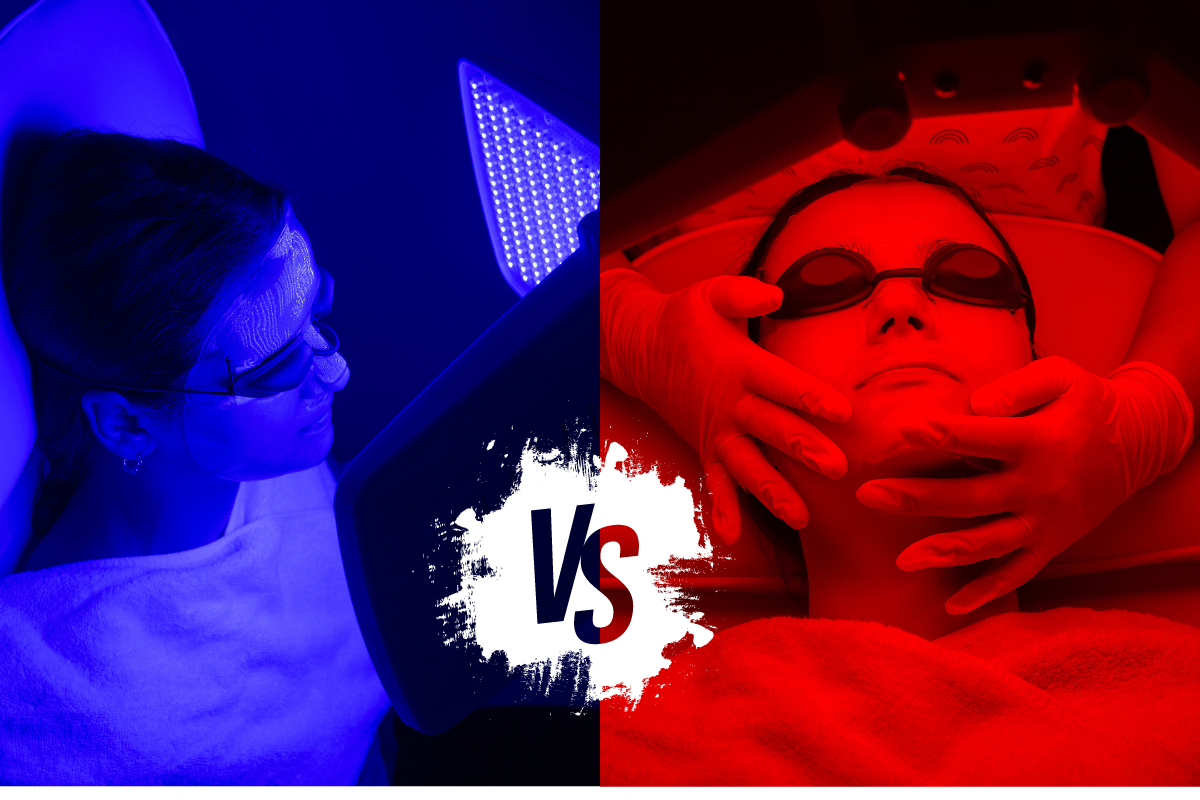Light therapy has recently gained popularity as a non-invasive and drug-free approach to treating various conditions. It involves using specific wavelengths of light to stimulate cellular activity and promote healing in the body. Two of the most common forms of light therapy are red and blue light therapy.
Red light therapy promotes skin health and rejuvenation, pain relief, and wound healing, while blue light therapy is commonly used for treating acne and Seasonal Affective Disorder (SAD).
This blog post will explore the differences in red versus blue light therapy, their respective benefits, and the scientific evidence supporting each therapy. We will also discuss safety considerations and provide recommendations for those considering light therapy. By the end of this post, you will better understand which therapy is best suited for your needs and how to safely and effectively incorporate light therapy into your wellness routine.
Red Light Therapy
Red light therapy, also known as low-level laser therapy or photobiomodulation, involves using red light wavelengths to stimulate cellular activity and promote healing in the body. This therapy works by penetrating the skin to reach the cells and tissues underneath, which helps to promote blood flow and the production of collagen and elastin.
Red light therapy has various benefits, making it a popular choice for those seeking a non-invasive, drug-free approach to treating various conditions. Some of the key benefits of red light therapy include the following:
- Skin health and rejuvenation: Red light therapy can improve the appearance of wrinkles, fine lines, and age spots while improving skin texture and tone. This is because red light therapy stimulates collagen production, a protein that helps keep skin looking firm and youthful.
- Pain relief: Red light therapy can be used to relieve pain in a variety of conditions, including arthritis, tendonitis, carpal tunnel syndrome, and chronic pain. It works by reducing inflammation and promoting the production of endorphins, which are the body’s natural painkillers.
- Wound healing: Red light therapy can promote the healing of various wounds, including burns, ulcers, and surgical incisions. It works by increasing blood flow to the affected area, which helps to speed up the healing process.
- Improved mood and energy: Red light therapy has been shown to improve mood and energy levels in those suffering from depression and anxiety. It works by increasing the production of serotonin, a neurotransmitter that regulates mood and energy.
- Improved sleep: Red light therapy can help to improve sleep quality by regulating the body’s production of melatonin, a hormone that regulates sleep-wake cycles.
- Improved athletic performance: Red light therapy can improve athletic performance by reducing muscle soreness and fatigue, improving muscle recovery time, and increasing endurance.
Red light therapy is a versatile and effective therapy that can improve various conditions. Its non-invasive, drug-free approach makes it a safe and popular choice for those seeking natural ways to promote healing and wellness.
Scientific studies have supported the use of red light therapy for a variety of conditions. A 2014 study published in the journal Photomedicine and Laser Surgery found that red light therapy was effective in reducing the appearance of wrinkles and improving skin texture in a group of participants. Another study published in the Journal of Physical Therapy Science in 2015 found that red light therapy effectively reduced pain and improved function in patients with knee osteoarthritis.
Blue Light Therapy
Blue light therapy is a form of light therapy that involves using blue light wavelengths to treat various conditions. This therapy works by penetrating the skin to reach the sebaceous glands responsible for producing oil. Blue light therapy helps to kill the bacteria that cause acne, reduce inflammation, and regulate oil production.
Blue light therapy is a popular form of light therapy with various benefits and uses. Here are some of the key benefits and uses of blue light therapy:
- Acne treatment: Blue light therapy is an effective acne treatment, as it helps to kill the bacteria that cause acne and reduce inflammation. It benefits those with mild to moderate acne that has not responded well to other treatments.
- Seasonal Affective Disorder (SAD) treatment: Blue light therapy can treat SAD, a type of depression that occurs during winter when there is less sunlight. It works by regulating the body’s production of melatonin, a hormone that regulates sleep-wake cycles and can become disrupted during winter.
- Skin conditions treatment: Blue light therapy can be used to treat a variety of skin conditions, such as psoriasis and eczema. It works by reducing inflammation and promoting healing in the affected area.
- Dental treatment: Blue light therapy can be used in dental settings to treat gum disease and reduce tooth sensitivity.
- Sleep disorders treatment: Blue light therapy can treat sleep disorders such as insomnia, as it can help regulate the body’s melatonin production and improve sleep quality.
- Seasonal allergy treatment: Blue light therapy effectively reduces the symptoms of seasonal allergies, such as runny nose, congestion, and itchy eyes.
- Mood enhancement: Blue light therapy has been shown to improve mood and energy levels in those suffering from depression and anxiety. It works by increasing the production of serotonin, a neurotransmitter that regulates mood and energy.
Overall, blue light therapy is a versatile and effective therapy that can be used to treat a variety of conditions. Its non-invasive, drug-free approach makes it a safe and popular choice for those seeking natural ways to promote healing and wellness.
Comparison Between Red and Blue Light Therapy
Red and blue light therapy differ in wavelengths, penetration, and effects. Red light therapy uses longer wavelengths of light, penetrating deeper into the skin, improving circulation, reducing inflammation, and promoting healing. Blue light therapy, on the other hand, uses shorter wavelengths that target the sebaceous glands and can kill the bacteria that cause acne, reduce inflammation, and regulate oil production.
Each therapy is best suited for specific conditions. Red light therapy is best for skin rejuvenation, pain relief, and wound healing. Blue light therapy is best for treating acne, Seasonal Affective Disorder (SAD), and other skin conditions such as psoriasis and eczema.
It is essential to select the correct therapy for the desired outcome. Choosing the wrong therapy can result in little or no improvement in symptoms or even worsen the condition.
Safety Considerations
While red and blue light therapy is generally safe, there are some possible side effects to consider. Red light therapy may cause mild side effects such as temporary eye strain, headache, or nausea. Blue light therapy may cause temporary skin redness, dryness, or irritation.
To ensure safety, wearing protective eyewear during treatment and avoiding overexposure to light is important. Follow the manufacturer’s instructions carefully and consult a healthcare provider before beginning any light therapy treatment.
People with certain medical conditions should avoid or use caution when using light therapy. For example, people with photosensitive skin, certain eye conditions, or those taking medications that increase sensitivity to light should avoid or use caution with blue light therapy. Consult a healthcare provider before beginning any light therapy treatment to ensure it is safe and appropriate for your needs.
Bottom Line
Red and blue light therapy are popular light therapy forms with different wavelengths, penetrations, and effects. Red light therapy is best for skin rejuvenation, pain relief, and wound healing, while blue light therapy is best for treating acne, Seasonal Affective Disorder (SAD), and certain skin conditions.
If you are considering light therapy, it is important to select the correct therapy for your desired outcome and to take necessary safety precautions. Before beginning any light therapy treatment, it is essential to consult a healthcare provider to ensure it is safe and appropriate for your individual needs.
Future research possibilities for light therapy are promising, with ongoing studies examining the potential benefits for conditions such as Alzheimer’s disease, Parkinson’s disease, and fibromyalgia. As research continues, light therapy will likely become an even more important tool for promoting healing and wellness.
In summary, whether you choose red or blue light therapy, both have a range of benefits and uses that can improve your overall health and well-being. By understanding the differences between the two and taking necessary safety precautions, you can experience the full benefits of light therapy and achieve your desired outcome.
FAQ
Is red or blue light therapy more effective?
The benefits of red light treatment are greatest for long-term skin issues like aging, scarring, and elasticity loss. Blue light treatment is the best option for severe skin issues like oil production, enlarged pores, hyperpigmentation, and breakouts.
When should red or blue light be used?
Red light therapy penetrates the skin to increase collagen production and lessen swelling. In the meantime, blue light penetrates the pores and kills bacteria to treat skin disorders like acne. To help with pain and stiffness, infrared light, on the other hand, penetrates deeply into the muscles.





